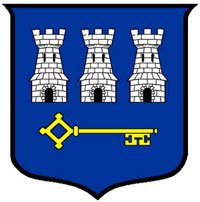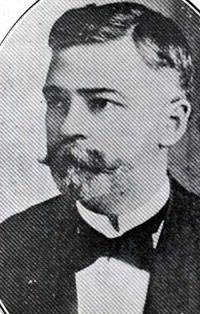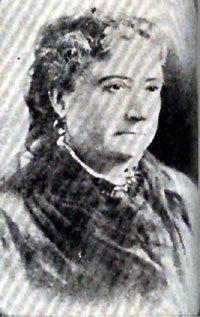|

City of Havana, coat
of arms.
|
Warships
entered the port of Havana between 3 and 5 August 1780
carrying around eight thousand men under the command of
Lieutenant General Victorio de Navia, army general and
chief of operations in America. These troops were made up
of the Soria, Aragón, Flandes, Hibernia, Guadalajara and
Cataluña regiments, who stayed in the houses and quarters
of Guanabacoa, Regla, Jesús del Monte and neighbourhoods
outside the walls, with the High Command, generals, other
high-level chiefs and also some of the troops staying
inside the capital.
That same
year Spain reconquered West Florida and under the peace
agreement reached in Versailles, in 1783 East Florida was
also handed over by England. In order to take possession
of the latter territory, on 19 June 1784 Brigadier Vicente
de Céspedes left the port of Havana with a force of
six-hundred men from the Rey, Dragones and Hibernia
regiments, the latter made up of Irishmen.
Several
hundred Irish soldiers destined for Florida passed through
Havana under the direct command of officers like
Lieutenant Colonel Hugo O’Connor, captain in the Hibernia
infantry regiment, who was given the command of the
Company of Grenadiers of the first battalion of this
regiment which was left vacant by the retirement of its
leader, Juan Hogan, in August 1784.
In the
second half of the eighteenth century various
descendants of Domingo Madan y Grant and his wife Josefa
María Commyns, both Waterford natives, arrived in Havana
from Tenerife, Canary Islands. At the beginning of the
next century the Madans had settled in the city and were
in business under the company name Madan, Nephews and Son.
Later, several of them settled in the Matanzas area and
would become part of the Cuban aristocracy with the title
Count of Madan. Through marriage the Madans became
connected to the Alfonsos who formed a powerful economic
group with the Aldamas, linked to the operations of the
German bank Schroeder which had its headquarters in
England and which financed railway companies in Cuba.
Since
colonial times one of the streets in Matanzas, near the
bridge of the Yumurí river, was called Madan, as was a
neighbourhood of the Carlos Rojas municipal district, also
in Matanzas province.
|

Dr.
Domingo Madan
(Adolfo Dollero, Cultura cubana, la provincia
de Matanzas y su evolución. Habana, 1929)
|
As the
eighteenth century was coming to a close, the Spanish
Crown assigned the Count of Jaruco and Mopox the mission
of heading a Public Works Commission that would be in
charge of studying the existing conditions favourable to
the colonisation of the island. Among those who formed
part of this commission was the navy officer Juan Tirry y
Lacy, born in Spain and son of Guillermo Tirry,
Grand
Standard-bearer
of Cádiz
and Governor of Puerto de Santa María, who was granted the
title Marquis of Cañada de Tirry by Royal Dispatch on 28
September 1729.
Juan Tirry
y Lacy was responsible for mapping Isla de Pinos,
modern-day Isla de la Juventud, where he went with the
mission of analysing the pine trees to see if they could
be used for the ships in the Spanish navy. He also wrote a
memoir of that region which gave rise to the Reina Amalia
colony in 1828. In honour of his contributions to
geography, the northernmost point of Isla de Pinos was
called Punta de Tirry. In Havana Juan Tirry was the
engineer general, was twice mayor of the city and Governor
of Matanzas in 1816, a city where one of the streets bears
his name. In May 1824 he inherited the title of Marquis
Cañada de Tirry, which he retained until he
died fifteen years later.
In June
1798 Sebastián Kindelán O´Regan, son of Vicente Kindelán
Loterell-Loterelton, originally from Ballymahon in County
Longford, was named political and military Governor of the
Santiago de Cuba garrison. His sister, María de la
Concepción, married to Phillippe O’Sullivan, Count of
Berehaven, died in Havana in August 1771. In July 1810
Santiago Kindelán was transferred to Florida with the same
position and from there he returned with the rank of
King’s Lieutenant, and later came to occupy the post of
second corporal and sub-inspector of the troops on the
island.
Due to the
death of Nicolás Mahy in July 1822, Sebastián Kindelán
assumed the role of interim Captain General and governed
the island for almost a year until May 1823 when Francisco
Dionisio Vives took over. He died three years later having
retired to his hacienda in Santiago de Cuba where he had
founded an illustrious family. He had attained the rank of
Field Marshall. Two geographical points in Cuba bear the
name Kindelán, one of them is a Cupeyes neighbourhood in
the municipal district of Morón, and the other is a
neighbourhood in Matanzas near the border with Sagua la
Grande.
During the
first third of the nineteenth century there was a wave of
immigration towards the island of settlers from different
European countries and North America, amongst whom there
were also Irish people who participated in the foundation
and development of two new towns.
In 1819 on
the southern coast of the island’s central region on the
banks of the Jagua River, a town of the same name was
founded, and was later renamed Cienfuegos. The first
settlers were from Bordeaux in France, and were joined by
settlers from the United States of America. On 30 December
of the same year 99 people arrived from Philadelphia, and
in this group were the Irish migrants Guillermo Carr,
Patricia Collins, Jaime Riley, his wife María Mac Donald
and his daughter Ana, Juan Boyle, Cristina Paulinger and
their sons Sebastián and Juan, Juan Hotton and his wife
María Guerty, Juan Conrad and his wife Luisa Owns, Felipe
Honery, his wife Cecilia and son Guillermo, Juan Miller
and his wife Lidia Sybbs, a North American, Francis
Farland, John Byrnes and Jaime Collins.
On 21
December 1826 a ship called Revenue entered Baracoa
port in the extreme east of the island with 40 people on
board arriving from the United States, who came with the
purpose of settling on the banks of the Moa River and
forming a colony there. These settlers were mainly from
Ireland, Scotland and the United States. The Irish group
was formed by the labourers Joseph Ocons and his wife,
Richard Powers, his wife and a child, Lawrence Heigar, his
wife and a child, Robert Irving, Peter Higgins and Mathew
Mac Namara, the carpenters Patrick Ollvan, James Mac
Namara, John Blakeney and Simon Dorn, and the blacksmith
Michael Mac Namara.
|

Juana Byrne
(Matanzas s.a.)
|
Besides
John Byrnes, a settler in Cienfuegos town, in the same
period other people of the same name lived on the island,
probably his relatives. In June 1855 a boy named Juan
Byrnes, whose father was Gregorio and his godmother
Margarita Byrnes, was baptised in Havana. This surname
became part of the heart of the intellectual community of
Matanzas. Firstly, this happened through the educational
work of Juana Byrnes de Clayton, the first headmistress of
the school for poor girls. This school would later become
the Casa de Beneficencia, founded in 1846, and later
through the literary work of the poet and revolutionary
journalist Bonifacio Byrne (1861-1936), who earned the
title of national poet for his patriotic independence
work. A street in the Los Olmos neighbourhood in Santiago
de Cuba, which bears the name of this distinguished Cuban,
is the expression of the permanent tribute paid to him.
The city
of Cienfuegos bears the mark of the Irish settlers in its
neighbourhood of the north part of the Jagua Bay which has
the name O’Bourke and was founded at the end of the War of
Independence in a parcelling of lots conducted by Miguel
O´Bourke Ramos. Juan O’Bourke, who was born in Trinidad
around 1826 and twenty-five years later took part in the
armed uprising of July 1826 organised by Isidoro
Armenteros, collaborator of the expansionist general
Narciso López, lived in this city from 1839. The young
revolutionary Juan O’Bourke was arrested and later
condemned to ten years in prison in Ceuta from whence he
escaped and headed to the United States.
Juan
O’Naghten y O’Kelly was originally from Athlone, County
Westmeath and travelled to Spain in 1747, where he served
at every level of the Irlanda Infantry Regiment. He had
attained the rank of brigadier before he died in October
1837. One of his sons, Tomás O’Naghten Enríquez, also an
officer in the same regiment and who also came to Havana,
died in this city in 1842. The Cuban branch of the
O’Naghtens inherited various titles of Spanish nobility
through marriage, among them those of Count of Casa Bayona
and Count of Gibacoa. Some family members lived in the
Chacón house on the street of the same name on the corner
with San Ignacio, in Havana.
The Irish
presence was particularly notable during the construction
of the island’s first railway, from Havana to Güines from
1835 and 1838, as described in Brehony’s article in this
journal. By Royal Order of 12 October 1834 the Junta de
Fomento de Agricultura y Comercio (Agriculture and Trade
Board) was authorised to build a railway from Havana to
the town of Güines. For this purpose financing was
arranged with the English banker Alejandro Robertson, who
was an agent of the Railway Corporation of London.
On 31
March 1835 a public document approved by Captain General
Miguel Tacón was signed in New York naming Benjamin Wright
head engineer and main consultant for the railway project,
Alfredo Krueger, first engineer, and Benjamin H. Wright,
son of the former, as second in command, directing and
carrying out the project. The Junta de Fomento brought the
technicians, foremen, superintendents and a group of
workers made up of 273 men and 8 women from the United
States under contract, among whom were English, Irish,
Scottish, North American, Dutch and German labourers.
However, they were all identified as Irish, perhaps due to
the greater numbers of those of that nationality. |



